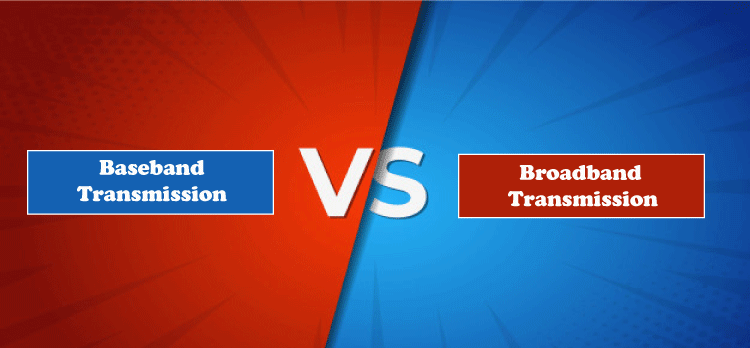Key differences between Baseband and Broadband Transmission

Baseband and broadband transmission are two different methods of transmitting signals over communication mediums. Here are the key differences between them:
-
Frequency Range:
- Baseband Transmission: In baseband transmission, the entire bandwidth of the communication medium is used to transmit a single signal without modulation onto a carrier wave. It typically operates within a narrow frequency range close to zero hertz.
- Broadband Transmission: Broadband transmission divides the available bandwidth of the communication medium into multiple frequency bands or channels. Each channel can carry its own signal, allowing for simultaneous transmission of multiple signals over the same medium. It operates within a wider frequency range than baseband transmission.
-
Multiplexing:
- Baseband Transmission: Baseband transmission does not support multiplexing multiple signals onto a single communication medium. It uses the entire bandwidth of the medium to transmit a single signal.
- Broadband Transmission: Broadband transmission utilizes frequency division multiplexing (FDM) techniques to divide the available bandwidth into multiple channels. Each channel can carry its own signal, enabling the simultaneous transmission of multiple signals over the same medium.
-
Signal Complexity:
- Baseband Transmission: Baseband transmission typically involves simpler signal encoding methods, such as amplitude modulation (AM), frequency modulation (FM), or digital encoding schemes like pulse amplitude modulation (PAM) or pulse code modulation (PCM).
- Broadband Transmission: Broadband transmission systems may involve more complex signal processing and modulation techniques to support multiple signals and channels. This includes techniques such as phase modulation (PM), quadrature amplitude modulation (QAM), or orthogonal frequency-division multiplexing (OFDM).
-
Distance and Attenuation:
- Baseband Transmission: Baseband transmission is generally limited to shorter distances due to signal degradation and attenuation over longer transmission lines. It is commonly used in local area networks (LANs) and short-range communication systems.
- Broadband Transmission: Broadband transmission is suitable for long-distance communication networks, as it can mitigate signal degradation and attenuation over extended transmission lines through the use of amplifiers, repeaters, and signal regeneration techniques.
-
Data Rates:
- Baseband Transmission: Baseband transmission may have lower data rates compared to broadband transmission systems, especially over longer distances.
- Broadband Transmission: Broadband transmission systems typically offer higher data rates and throughput compared to baseband transmission systems, making them suitable for high-bandwidth applications.
-
Examples:
- Baseband Transmission: Examples of baseband transmission include Ethernet networks, serial communication interfaces, and analog audio signals.
- Broadband Transmission: Examples of broadband transmission include cable modem technology, digital subscriber line (DSL) technology, and fiber optic communication networks.
In summary, baseband transmission uses the entire bandwidth of the communication medium to transmit a single signal, while broadband transmission divides the available bandwidth into multiple channels to transmit multiple signals simultaneously. Broadband transmission supports higher data rates, longer distances, and multiplexing of multiple signals, making it suitable for a wider range of applications compared to baseband transmission.
Thank you,
